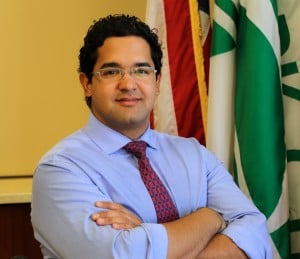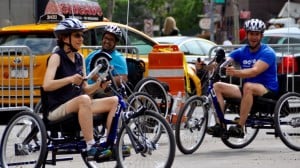1800wheelchair caught up with Quemuel Arroyo of New York City’s Department of Transportation during Summer Streets this past August. Quemuel was out with a dozen Invacare handcycles, which anyone could try out for themselves.
We caught with Quemuel recently to find out more about the Summer Streets program and the man, himself:
Q: Tell us a little about yourself. Where did you come from and how did you end up at the DOT?
 A: Though I was born in Dominican Republic, I consider myself a native New Yorker. I first came to NYC when I was three months old and grew up travelling between the DR and NYC. At eighteen I endured a spinal cord injury while downhill mountain biking in Vermont. It was then when I became a member of disability community and an advocate for inclusion and access. Shortly after my accident, I attended New York University where I earned a bachelors of arts in Urban Design and History of Architecture. After NYU, I work at Morgan Stanley before coming to the New York City Department of Transportation.
A: Though I was born in Dominican Republic, I consider myself a native New Yorker. I first came to NYC when I was three months old and grew up travelling between the DR and NYC. At eighteen I endured a spinal cord injury while downhill mountain biking in Vermont. It was then when I became a member of disability community and an advocate for inclusion and access. Shortly after my accident, I attended New York University where I earned a bachelors of arts in Urban Design and History of Architecture. After NYU, I work at Morgan Stanley before coming to the New York City Department of Transportation.
Q: What’s your role at the DOT?
A: I am the Policy Analyst for Accessibility and ADA coordinator at NYC DOT.
Q: What kind of programs and initiatives are you involved in?
A: Ranging from our Staten Island Ferry to our street plazas and 789 bridges, I oversee all matters of accessibility for the agency.
Q: What was the genesis of the handcycle program? How was it received on Summer Streets? What’s next for those handcycles?
 A: This past summer NYC was ranked one of the top cycling cities in the US. A cyclist myself, I wanted to provide New Yorkers with disability the opportunity to bike like everyone else. Our hand-cycling pilot started as one of many activations during Summer Streets 2015. The public loved the bikes! In three Saturdays, we had close to 900 people ride the 10 hand-cycles we purchased for this pilot. We are still in the pilot stage for hand-cycling and are looking to partner with sister agencies like the park department to gather more feedback on the bikes and assess the publics’ interest in hand-cycling.
A: This past summer NYC was ranked one of the top cycling cities in the US. A cyclist myself, I wanted to provide New Yorkers with disability the opportunity to bike like everyone else. Our hand-cycling pilot started as one of many activations during Summer Streets 2015. The public loved the bikes! In three Saturdays, we had close to 900 people ride the 10 hand-cycles we purchased for this pilot. We are still in the pilot stage for hand-cycling and are looking to partner with sister agencies like the park department to gather more feedback on the bikes and assess the publics’ interest in hand-cycling.
Q: Coming from the private sector, how are things different in the public sector?
A: There are many differences working in the public sector, but above all, the responsibility I feel to doing right by all New Yorkers, and specific to my role, New Yorkers with disabilities is real. I am here to represent over 800,000 New Yorkers with disabilities and I think about that every time I enter my office.
Q: Outside of work, what kinds of things are you interested in?
A: I try to stay active and involved outside of work. I have a strong believe in education and particularly in providing quality education to disenfranchised urban youth in New York City. I feed that passion in my works as a board member of New York City Outward Bound Schools and the New York University Alumni Board. After my accident, I was inspired to pursue a fulfilling life by Project Sunshine, an incredible not for profit, and now I am one of their global ambassadors and volunteers. I am avid swimmer and continue to swim regularly at my local YMCA where I once was a lifeguard. I rock-climb regularly and as often as possible, enjoy getaway trips for scuba diving and skiing.
Images:
Courtery of Quemuel Arroyo & Barrier Free Living